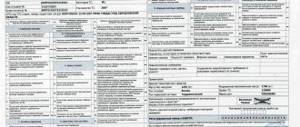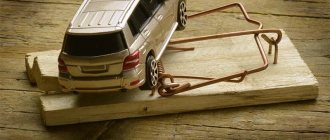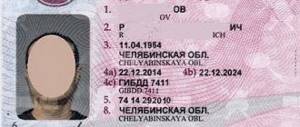Any transport, be it land, air or water, must undergo timely technical inspection due to the fact that it always represents an object of increased danger. And any serious malfunctions in it can lead to damage to other people’s property, not to mention harm to the health or lives of other people - road users or other traffic.
The frequency of technical inspection, as well as the rules for checking the technical condition of a vehicle, are currently regulated by Federal Law No. 170-FZ “On Technical Inspection of Vehicles” dated July 1, 2011.
Only special authorized service stations (operators and dealers) with state accreditation can carry out maintenance in 2021. The absence of a valid diagnostic card can threaten the driver with many troubles, from administrative fines (for some categories of vehicles) to the inability to obtain compulsory motor liability insurance and problems in the event of an accident.
What is a diagnostic card?
The diagnostic card is a replacement for a vehicle inspection certificate. It is issued to drivers if the car's technical inspection has been successful, and is a double-sided sheet of paper in standard A4 format. It can be black and white or made in different colors, but the content of the card does not change. The card contains a table in which basic information about the technical condition of the car is entered and a conclusion is given about its approval or non-admission for operation.
The diagnostic card is drawn up in two copies, one of which is given to the driver, and the other remains in the service center for 3 years. Additionally, the information is duplicated on a computer and then stored in the unified technical inspection information database EAISTO. There, the card is assigned a unique number by which it can be found in this database at any time.
The diagnostic card will be stored in the EAISTO database for 5 years or more, depending on the type of vehicle and other variables.
The convenience of constantly finding technical inspection data in the electronic database also lies in the fact that if you lose the paper version of the diagnostic card, you can get a duplicate of it very quickly, just contact your technical operator, who carried out the maintenance of the vehicle.
There is no need to carry the diagnostic card with you all the time. Traffic police inspectors do not have the right to demand it from the driver. But there are also exceptions. Drivers of passenger taxis, trucks with no more than 8 passenger seats, buses and cars transporting dangerous goods must undergo maintenance every 6 months and always carry a diagnostic card with them. Otherwise, they will face an administrative fine of 500 to 800 rubles.
However, without a diagnostic card it will be almost impossible to obtain an MTPL policy. Insurance companies must be sure that their client’s vehicle is in good technical condition.
For what reasons do they refuse maintenance at the dealer?
More than 15% of car enthusiasts prefer to either lose the warranty or go into conflict with the dealer, but have their car serviced at normal prices in a car service center that is licensed by the manufacturer. Here are the main reasons for this choice:
Reason #1: Cost of routine maintenance.
Almost any work for which the official service charges huge bills can be done at a third-party station. Don't get hung up on the fact that it's not branded. Today there are many car services that specialize in cars of a specific brand and have the appropriate licenses. They have all the necessary equipment, knowledge and skills to complete any task, including engine overhaul and “brain rewiring”. And this at a lower cost, when costs do not take the last bit out of your pocket.
Reason No. 2: the cost of spare parts and additional equipment.
Official services use only original consumables and spare parts during repairs. As for ordinary car services, they don’t care in this regard: they can use any spare parts that meet quality requirements, so the choice is up to the client. Naturally, non-original products are cheaper than original ones. But in each individual case it is worth consulting with professionals, since quite often there are fakes whose quality is frankly poor.
Reason #3: queues for service.
There are almost always queues at branded service stations, and quite long ones at that. As for private stations, things are simpler there. If the owner notices a strong increase in the flow of clients, then he hires additional craftsmen, or simply extends the working day, raising workers’ wages. As a result, everyone is happy.
Reason No. 4: feeling of falsehood.
Most “officials” have a master who accepts orders for car repairs - a respectable manager, dressed in a good suit, who smiles all the time. Naturally, it is very pleasant to communicate with such a person, but people come to the service station not for conversations, but for repairs. Things are much simpler with ordinary stations, where it is possible to talk directly with those people who will be involved in repairs. Such conversations are much more constructive.
Reason #5: approach to repairs.
Branded stations have one feature - they never do small and painstaking work. If something doesn't work, they replace the entire assembly, not just one part. For example, if the automatic transmission breaks down, no one will tinker with it and figure out what the cause of the malfunction is. The craftsmen will simply install a new box, for which the owner will have to pay a tidy sum. But the problem may be some small thing that can be fixed much cheaper.
Reason No. 6: impossibility of being present during maintenance.
At any official service station you will be offered special rooms with installed screens, where customers can sit comfortably and watch how the masters work on their cars. Access to the premises where repairs are being carried out is closed. And this is bad if it becomes impossible to personally control the process. Ordinary craftsmen have nothing against the client observing their work, as long as he does not get under his feet.
Reason No. 7: the skill level of the mechanics.
Most good private car services employ real professionals in their field. Managers of private stations are well aware that the popularity of the service and, as a consequence, its profitability depend on the qualifications of their employees. That is why they spare no expense in hiring the best specialists. And they, as a rule, first hone their skills at branded service stations, and only then go to private owners, where they are offered better working conditions.
Reason No. 8: location of the official car service center.
Many official service stations are located in remote areas of cities. It makes no sense for them to gravitate towards the center, where the cost of renting premises is higher. In any case, they will have a constant flow of customers, since anyone who wants to maintain the guarantee will simply have to spend many hours getting to the desired service. In most cities, you can easily find several service stations or car services at once, which are located closer and charge several times less for their services.
Commentary with an eye to the Law
The law on the protection of consumer rights regarding the warranty period, including for a car, clearly states that all shortcomings that arose during the operation of the car are eliminated by the manufacturer or an authorized dealer at his expense.
If the driver, when operating the car, complies with all technical rules and regulations that the car manufacturer regulates in its Manual, he has no right to refuse a warranty for the car. The only exceptions are those cases in which it is established that a component or assembly of the machine has failed due to poor quality intervention. That is, simply put, if the gearbox is jammed, and before that a mechanic from the “Around the Corner” service climbed into it, then warranty service will definitely be denied.
Most manufacturers indicate in their operating manuals that the vehicle’s warranty remains subject to maintenance at an authorized dealer’s service center. This condition does not comply with the PPA.
Website editors
Publications on the topics: how to get a car loan, which car to choose for credit, conditions for car loans in banks for new and used cars, how to repay a car loan ahead of schedule, CASCO and MTPL insurance for a loan car. The editors of the “Car on Credit” website help you understand the issues of obtaining, repaying and servicing a car loan
Was this publication useful to you?
Bookmark it on social networks!
Total score: 3Votes: 74
Support for the auto industry - auto loans increase car sales growth
How to choose a used off-road car on credit - which model to take
We recommend other useful posts on this topic:
Support for the automotive industry - car loans increase the growth of car sales
New car on credit: details and subtleties of registration
Car loan without interest for a new car - what is the real benefit
A new car from a showroom - rules for buying a car at a showroom
Whether to take out a car loan or a consumer loan - which is better and more profitable to apply for?
New car on credit - all the pros and cons of buying
Frequency of technical inspection for different vehicles
The validity period of the diagnostic card is always indicated in the document itself; the frequency of maintenance varies not only for different types of vehicles, but also within the same group (for example, a passenger car can undergo technical inspection every year or every 2 years). What affects the frequency of inspection?
- The age of the car (meaning the number of years that have passed since it left the factory);
- Vehicle category;
- Purpose (transportation of people or dangerous goods, special transport).
To talk in detail about the frequency of inspection for different categories of vehicles, we will use the standard classification - driving categories, which are displayed on the back of the driver's license.
How much will the first maintenance cost?
As for the financial costs that are possible when undergoing the first maintenance of a car, they are not so great. Since the first maintenance, in most cases, is preventive, you will not need to spend money on expensive spare parts. However, costs depend on the established prices for the services of a service station and on the make of the car. Of course, you will need to provide a service book, where the technicians would put all the relevant marks on the completion of mandatory maintenance.
Motorcycles and mopeds (Category A and M)
For new cars and other vehicles from categories A and B, if they are not yet 3 years old (from the date of release, not purchase by the current owner), a technical inspection is not required. If we talk about category A, then the following vehicles belong to it:
- motorcycles and sidecars;
- four-wheeled vehicles with a maximum weight of not more than 400 kg;
- any low-power motorcycles whose engine capacity does not exceed 125 cc. see and whose power is within 11 kW (category A1).
Motor vehicles from category A undergo a new technical inspection (first) only 3 years after release (like a new car). From 3 to 7 years of age - every 2 years, from 7 years of age - every 12 months. The same applies to vehicles with category M, including mopeds and ATVs with an engine capacity of up to 50 cubic meters. cm.
What can prevent you from passing MOT?
The list of breakdowns that prohibit driving a car was approved in 2002. It has not been edited since then. Familiarize yourself with the prohibited positions in the technical regulations of the Customs Union.
The most common faults include:
- Optical elements. Lighting devices must operate correctly in accordance with the design features of the vehicle. Self-installed xenon or brake lights are prohibited. In most cases, you can adjust the headlights at the inspection point.
- The functioning of the wipers. Rear and front washers must be checked. If the windshield wipers perform their function slowly or incorrectly, the inspection mark will not be given.
- Rusty structural elements and brake hoses. They are a disqualifying fault, especially if they concern the side members and chassis. These elements are the most vulnerable to damage.
- The car windshield should not be broken. There are no scratches or chips in the driver's field of vision. Their darkening status is checked at diagnostic stations. If it is too strong, the diagnostician will send you away empty-handed.
- Tinting. Light transmission in the car must be at least 75%. Make any tint on the rear window. A small tinted stripe is allowed on the top of the windshield.
- Gap in the steering system. Much depends not only on the conditions of use, but also on the quality of the components themselves. Problems are usually caused by tie rod ends and steering gear components. They are detected during quick and short movements of the steering wheel. If you hear a distinctive knocking noise, contact your mechanic as soon as possible. Signs of wear include rapid driving and "scratches."
- The diagnostician will not miss the opportunity to look at the tires. The brand, size or shape of the tread must match. An unevenly worn tread will not pass maintenance. If the meter shows a result of less than 1.6 millimeters, the test will be negative. The same thing happens if a specialist notices a crack in the tire or other mechanical damage that disqualifies it.
- Lack of neutralizer. The toxicity of the exhaust is checked with a special gas analyzer. Modern vehicles, as a rule, comply with established GOST standards. It is important to understand that any reconstruction of the standard exhaust system jeopardizes the successful completion of maintenance. The exhaust must be sealed and the system must operate quietly.
Passenger cars (category B)
Cars and other vehicles belonging to this category also do not undergo maintenance for the first 3 years after release (like motorcycles). From 3 to 7 years of age - every 2 years, from 7 years and more - every year. Let us remind you exactly which cars belong to category B:
- passenger cars weighing less than 3.5 tons and the number of passenger seats no more than 8 (excluding the driver's seat);
- passenger cars weighing less than 3.5 tons and the number of passenger seats no more than 8 with a trailer weighing up to 750 kg;
- passenger cars weighing less than 3.5 tons and the number of passenger seats no more than 8 with a trailer weighing over 750 kg;
- ATVs, tricycles and other vehicles assigned to category B.
Other types of transport
City trams (category Tm) and trolleybuses (category Tb) are required to undergo technical inspection every 6 months if they carry passengers. If they are engaged in the transportation of goods, then the frequency is 1 year (every 12 months).
Maintenance frequency for other categories of transport:
- self-propelled construction equipment - every 12 months;
- tractors - every 12 months;
- transport used for seasonal work - before the start of work (but no later than 15 days after its start);
- trailers, semi-trailers of individuals - no MOT required;
- trailers, semi-trailers of legal entities - the frequency is the same as for motorcycles and passenger cars (the first 3 years are not necessary, from 3 to 7 years - every 2 years, more than 7 years - every 12 months);
- water transport - once every 5 years (exceptions - boats, water transport with a mass of less than 200 kg and a motor with a power of up to 8 kW, sports sailing vessels with a length of no more than 9 meters).
There are also separate categories of ground transport, for which their own inspection periods are established. Thus, every 6 months, passenger and cargo taxis (with no more than 8 passenger seats), as well as special vehicles whose purpose is the transportation of dangerous goods, undergo maintenance. Special-purpose vehicles equipped with special light and sound signals, as well as vehicles used to train future drivers, must undergo technical inspection annually (every 12 months).
WHO'S RESPONSIBLE?
“We were promised that from now on, inspection operators will be financially responsible for the conclusions issued. And if an accident occurs due to technical faults, the maintenance center employees will also be responsible.
Indeed, the diagnostic card, which is issued after a technical inspection, is certified by the seal of the enterprise and signed by a technical expert, that is, formally the operator is responsible with his reputation and money for the quality of the service provided. And the insurance company also has the formal right to sue the operator if the accident occurred due to a malfunction that was not identified during maintenance.
But this is rather from the category of good wishes. According to experts, it is very difficult to determine whether the faulty condition of the car was the cause of the accident. This requires special expertise. And to prove that the operator, due to negligence (or for another reason) during maintenance, did not notice the malfunction, and it became the cause of the accident... This is completely out of the realm of fantasy.
— I heard that some insurance companies offer to undergo maintenance without visiting special stations: they say that an expert will come, take all measurements on the spot and issue a maintenance coupon and a diagnostic card.
If the organization offering such a service is accredited by the RCA and has the necessary mobile equipment, there are no problems; You can check the car on any dry and level area. The issued documents will be accepted by any insurance company.
***
So, what is a “new inspection” - a benefit for the car owner or just an attempt to shift money from one pocket to another? A real technical inspection that helps improve safety, or just another formal procedure? So far, the gain is obvious for us: now the inspection can be done quickly, without a queue and inexpensively; It seems that the petty quibbles of experts are a thing of the past. We are going to find out how this procedure goes in the near future during a special raid.











